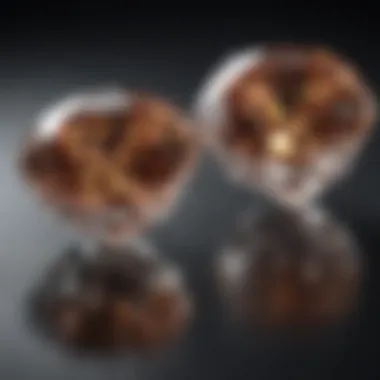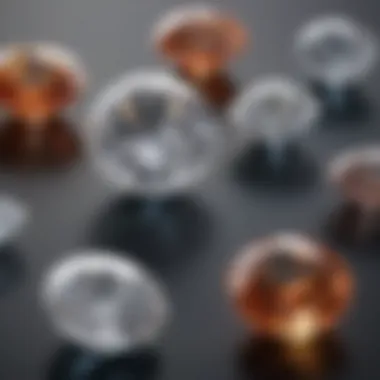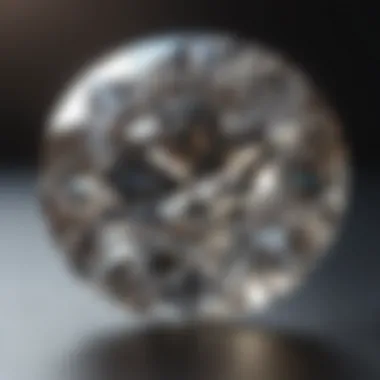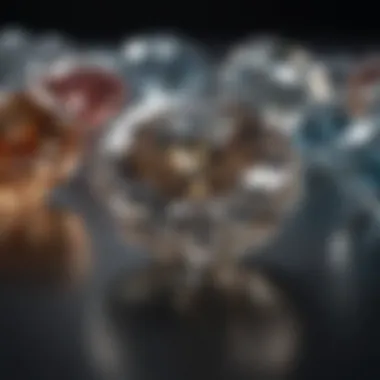Exploring Two to Three Carat Diamond Value


Intro
Purchasing a diamond is much more than a simple transaction; it's akin to choosing a piece of art or a legacy to pass on. Among the many options available, the allure of a two to three carat diamond rustles a unique charm and presence in the market. To truly appreciate the value of such gemstones, one must delve into the intricate tapestry of elements that define their worth. In this article, we shall embark on an exploratory journey, unearthing the various factors that influence pricing and understanding how these stones stack up against their smaller counterparts.
As we traverse this landscape, we'll focus on aspects like cut, color, clarity, and certification—each a vital cog in the intricate machinery of diamond valuation. We aim to provide insights that can help both enthusiasts and prospective buyers navigate this fascinating domain with more confidence. By the end, you'll find yourself equipped with knowledge to discern, appreciate, and perhaps even invest in your own two to three carat diamond, ready to sparkle brighter than the sun.
Gemstone Overview
Definition and Origins
Diamonds are not merely beautiful; they are the hardest natural substance known to man, formed deep within the Earth's crust under extreme pressure and heat. They consist primarily of carbon atoms that bond in a crystalline structure. The term 'carat,' a unit of weight for gemstones, fundamentally represents a diamond's size and, in many cases, its perceived value.
Diamonds trace their genesis to billions of years ago, emerging from volcanic activity that forces these precious stones to the surface. Over centuries, they have transcended mere mineral status, becoming symbols of love, power, and prestige. The fascination with diamonds goes far beyond their physical attributes; the lore surrounding them enriches their appeal, adding layers of significance and meaning.
Historical Significance
Throughout history, diamonds have often found themselves woven into the fabric of monarchies, with many claims of magical properties or divine status. In ancient India, diamonds were believed to possess protective qualities. The crown jewels of European royals, for instance, are adorned with remarkable diamonds that tell stories of wealth, conflicts, and grandiose displays.
As we move forward in time, the fascination with diamonds solidified their market reach, ushering in the modern diamond industry. The 20th century saw diamonds not just as luxury items but as essential elements in romance, spurred on by clever marketing campaigns promoting the notion of diamonds as symbols of eternal love.
Gemstone Properties
Hardness and Durability
An outstanding feature of diamonds is their hardness. Scoring a perfect ten on Mohs scale, they resist scratching and retain their sparkle far beyond any other gemstone. This durability is paramount for the purpose of jewelry that endures through lifetimes. However, despite this remarkable hardness, diamonds are not indestructible; they can break if subjected to force at certain angles, a testament to their unique structure.
Color and Clarity
When it comes to color, diamonds are often thought to be colorless, but the reality is that they come in a spectrum of hues. The clarity of a diamond refers to the absence of inclusions or blemishes. The ideal scenario boasts a perfectly clear diamond, though slight imperfections can make each stone distinctive. These characteristics play major roles in determining the overall value of the gem.
Consider the following regarding color and clarity:
- Color Grades: Ranging from D (colorless) to Z (light yellow or brown).
- Clarity Ratings: Such as Flawless (no inclusions or blemishes visible under 10x magnification) to Included (inclusions are visible to the naked eye).
In summary, two to three carat diamonds encompass a fascinating interplay of history, strength, and aesthetic value. Understanding these nuances is imperative for making informed decisions in this market. The journey through their properties and significance continues to unveil the deeper meanings that diamonds represent.
"A diamond doesn’t shine; it reflects the light." - Anonymous
As we navigate toward the factors influencing the valuation of these diamonds, we will explore crucial elements that set the tone for informed purchasing decisions.
Prolusion to Carat Weight
When diving into the diamond market, one term comes up often: carat weight. Understanding carat weight is pivotal, as it serves as a primary determinant of a diamond's value, influencing everything from price to desirability. In the realm of two to three carat diamonds, this significance magnifies. Buyers must consider what this weight represents—not just in terms of size, but also in the emotional and financial investment it entails.
Definition of Carat
A carat is a unit of weight used for gemstones and pearls, where one carat equals 200 milligrams. It's essential to understand that carat weight does not measure the dimensions of a diamond directly. Instead, it reflects the mass of the stone. This means a well-cut diamond can appear larger than a poorly cut diamond of equal carat weight, due to how light interacts with the facets.
Moreover, when it comes to larger diamonds—specifically those in the two to three carat range—people often perceive them as more valuable, leading to a heightened market demand. Larger diamonds tend to be rare, hence the weight can dramatically influence price. Size can also spark emotions, with many buyers considering larger carat weight as a status symbol.


Significance of Carat in Diamond Valuation
The significance of carat weight in the valuation of diamonds cannot be overstated. It operates at the intersection of perceived value and market dynamics. Here are key points illustrating its importance:
- Rarity: Larger diamonds are simply harder to find, making them more sought after. A two to three carat diamond, for example, is rare compared to smaller stones, leading to increased prices.
- Investment: A diamond is often seen as a long-term investment. Higher carat weights can indicate a sounder investment, partly due to larger stones retaining their value better over time.
- Size Matters: Beyond economics, emotional factors come into play. A larger diamond often holds more sentimental weight during significant life events, like engagements or weddings.
"A diamond isn't just a purchase; it's a legacy that often gets passed down through generations, intertwining sentiment and worth in a unique dance."
- Market Trends: The market for larger carat diamonds can fluctuate. Understanding these trends can provide insight into the best times to buy or sell.
In summary, carat weight isn’t just a number; it’s a profound indicator of a diamond's rarity, investment potential, emotional significance, and its place within market trends. Being aware of these facets allows buyers, collectors, and enthusiasts to make more informed decisions when navigating the intricate world of two to three carat diamonds.
Evaluating Diamond Worth
The process of evaluating diamond worth sits at the heart of understanding what makes a diamond valuable. It’s not merely about appraising a stone based on its sheer size; rather, it delves into a blend of artistry, science, and economics that ultimately determines a diamond's price. For two to three carat diamonds, this evaluation becomes even more nuanced, as these sizes often balance luxury without veering into exorbitance.
When you think about diamond valuation, the Four Cs of Diamonds—Cut, Color, Clarity, and Carat Weight—play a pivotal role. Each of these attributes considerably influences the worth of a diamond, making it essential for potential buyers or enthusiasts to grasp how each component fits into the bigger picture. Not only do these elements affect pricing, but they also shape the overall aesthetic appeal of the stone.
By diving deeper into each of these Four Cs, buyers can make more informed decisions. Understanding which aspects to prioritize based on personal preference and budget can dramatically shift the perceived value. For instance, choosing a well-cut diamond of a slightly lower color grade may yield a more brilliant stone than a higher color grade of lower cut quality. Therefore, it’s vital to approach the process of judging worth with a detailed and discerning mindset.
Four Cs of Diamonds
Cut
Cut is perhaps the most critical aspect when evaluating diamonds because it directly affects how light interacts with the stone. A diamond that is cut to precise angles, proportions, and facets will reflect light beautifully, displaying a sparkle that captivates onlookers. The term "brilliance" comes into play here, as well. A well-cut diamond can appear more radiant, regardless of its carat weight.
When purchasing a two to three carat diamond, opting for a superior cut often proves to be a wise decision. It not only enhances visual appeal but also raises the market value. However, it’s worth noting that an over-emphasized cut may lead to compromise on other attributes, which is something a savvy buyer should keep in mind.
Color
Color grading will assess how closely a diamond approaches the no-color state. Diamonds closest to colorless are the most sought after and tend to fetch higher prices. Yet, the subtle hues present in light-colored diamonds vary—and can sometimes be a matter of personal preference. A near-colorless diamond may provide a more pleasing aesthetic within a more budget-friendly price range.
In the context of two to three carat diamonds, the color rating provides a valuable opportunity to balance quality with cost. Expensive colorless diamonds might not always be within a buyer’s reach, making lightly tinted stones a practical and beautiful alternative.
Clarity
Clarity can be seen as the diamond’s signature; it reveals the gem’s uniqueness and tells its story. Clarity grading examines internal imperfections known as inclusions, and external ones termed blemishes. For diamonds in the two to three carat range, having fewer visible inclusions can have a substantial impact on the valuation.
Despite not all inclusions being visible to the naked eye, they do influence a diamond's desirability. Striking a balance between clarity and other Cs will ensure that you find a beautiful piece that fits your specific criteria while still appearing magnificent.
Carat Weight
Carat weight, while often viewed as a straightforward metric, carries implications far beyond just the number. For many, a larger carat size might appear more impressive, but it’s important to not forget the relationship between carat and the other Cs. The value shifts when a slightly smaller but significantly better-cut diamond may outshine a larger counterpart.
In two to three carat diamonds, the allure of carat weight can heavily impact a buyer's choice. It’s all about balancing the ratio of carat weight with cut, clarity, and color to maximize value for one's investment.
Influence of Cut Quality on Price
The quality of the cut can either inflate or deflate a diamond's price dramatically. A diamond with an excellent cut can command up to 30% more than an equivalent one with a fair cut. This makes cut quality an essential topic to explore further when looking into the overall worth of a diamond, particularly in the sought-after two to three carat class.


Market Trends and Pricing Strategies
In the realm of diamond purchasing, especially in the two to three carat range, market trends and pricing strategies are crucial components that can significantly influence a buyer's decision. As consumers navigate this landscape, understanding the nuances of pricing can lead to more informed choices, ultimately impacting personal satisfaction with their investment.
The market for diamonds is not static. It's swayed by seasonal demand, consumer preferences, and prevailing economic conditions. The trends observed in this segment are indicative of larger patterns that often mirror societal attitudes toward luxury items. Right now, the interest in two to three carat diamonds is particularly notable, with more buyers leaning towards these sizes due to their balanced blend of presence and wearability.
Current Market Prices for Two to Three Carat Diamonds
As of recent data, the price range for two to three carat diamonds fluctuates significantly based on a host of factors. Generally, two carat diamonds can retail between $8,000 to $20,000, while three carat stones often start from around $15,000 and can climb upwards of $30,000 or more. However, these numbers are not set in stone. Pricing is affected by the stone's quality, as defined by the Four Cs—cut, color, clarity, and carat weight.
It's also important to note that the price per carat for diamonds tends to increase as the size goes up. Buyers can expect to pay significantly more for a three carat stone than for two one carat diamonds, for example, due to the rarity and desirability of larger stones.
Comparison with Smaller and Larger Carat Diamonds
When comparing the two to three carat diamonds to both smaller and larger options, several dynamics come into play. Smaller diamonds, while often more affordable, may lack the same level of presence. A one carat diamond may offer considerable value, but the visual impact pales in comparison to the same quality in two or three carats.
On the flip side, larger stones can offer a wow factor that draws attention but come with a hefty price tag. A four carat diamond can easily exceed $50,000, depending on its overall quality. The demand for smaller diamonds, often seen in everyday fashion or as starter engagement rings, contrasts sharply against the allure and prestige of larger stones.
In essence, two to three carat diamonds represent a sweet spot where size, presence, and pricing converge. Many buyers consider these as an optimal choice; they stand out yet remain manageable in terms of budget and practicality.
Role of Economic Factors in Pricing
Economic factors also hold considerable sway over the diamond market. The overall economy influences consumers' disposable income and willingness to spend on luxury items. When economic conditions are favorable, such as low unemployment rates and increasing consumer confidence, diamond sales tend to surge. Conversely, during economic downturns, luxury purchases decline as consumers tighten their belts.
Additionally, fluctuations in precious metal and diamond supply chains—affected by anything from geopolitical stability to mining operations—can alter prices scene.
"Understanding market forces is essential for any diamond buyer. It determines not just what you pay, but also what you can expect in terms of quality and value retention."
In closing, the value of two to three carat diamonds is shaped not only by individual characteristics but also by broader trends and economic environments. Staying informed about these factors can empower buyers to make choices that resonate with their personal values without losing sight of fiscal responsibility.
Certification and Grading
When diving into the world of diamonds, one cannot overlook the significance of certification and grading. These two aspects are crucial not just for assessing a diamond’s value but also for ensuring its authenticity and quality. Many buyers may feel a rush of excitement when purchasing a diamond, but understanding certifications can temper that enthusiasm with informed decision-making.
Importance of Certification in Valuation
Certification plays a vital role in establishing a diamond's legitimacy and worth. A certified diamond carries a report from a reputable gemological laboratory, detailing essential aspects such as its carat, cut, color, and clarity. This document acts as a diamond's "birth certificate," providing proof that the stone has been evaluated by trained professionals.
The benefits of certification are manifold:
- Trustworthiness: With a proper certification, buyers can be more confident that they are paying for what they think they are buying.
- Transparency: It allows potential buyers to see detailed measurements and assessments, which provide invaluable insight into the diamond's overall quality.
- Resale Value: In case the owner decides to sell the diamond in the future, a certified stone generally fetches a better price on the market because its qualities have already been validated.
For many buyers, the thrill of owning a diamond can be overshadowed by the fear of making a costly mistake. Without certification, a diamond's authenticity is often questioned, leading to potential scams or misunderstandings in valuation. Thus, for anyone considering an investment in two to three carat diamonds, securing a certified piece is a foundational step.
Reputable Organizations for Diamond Certification
With certification being essential, the next question that pops up is: where should one get the diamond certified? Not all certifications are created equal, and thus, identifying reputable organizations is crucial. Here are a few well-regarded gemological institutes known for their stringent grading systems:
- Gemological Institute of America (GIA): Perhaps the most recognized name in diamond grading, GIA sets the standard in the industry with its fair and unbiased assessments.
- International Gemological Institute (IGI): Known for its global presence, IGI provides clear and comprehensive grading reports, covering various aspects including cut and quality.
- American Gem Society (AGS): This organization focuses on ethical practices and high grading standards, making their certification widely respected.


When selecting a diamond, look for reports from these organizations. They not only provide confidence in the purchase but also ensure that you are making a well-informed decision.
"A diamond isn’t just a stone; it’s a piece of art that deserves to be recognized by experts in the field."
In summary, as you navigate through the complexities of diamond valuation, remember that certification and grading form the backbone of what contributes to a diamond’s integrity and marketability. Thanks to these organizations, buyers can step forward with assurance and clarity, well-aware of the choices they are making.
Practical Considerations for Buyers
When venturing into the realm of two to three carat diamonds, understanding the practical considerations can make the difference between a wise purchase and buyer's remorse. It's not just about the bling; it's about ensuring that the chosen stone aligns with personal tastes and budget. A diamond is more than just a stone; it’s an investment, perhaps a lifelong treasure.
Deciding Between Two and Three Carats
The first major decision involves the selection between two and three carats. On the surface, it may seem like merely a numerical choice, but it goes deeper. A two-carat stone often provides a substantial presence while allowing buyers to stay within a comfortable price range.
Conversely, stepping up to a three-carat diamond can dramatically enhance its visual impact but often commands a premium. To put it simply:
- Two Carats: Balances beauty and budget effectively.
- Three Carats: Delivers more brilliance and size but can stretch finances.
When faced with this decision, think about the style of the wearer. A more understated elegance may favor a two-carat. In contrast, if admiration is what you seek, a three-carat stone shines like a beacon. This discussion also leads to examining how carat weight influences perceived size. Sometimes, a well-cut two-carat can appear larger than a poorly cut three-carat. Think carefully; it’s all in the visual presentation.
Understanding Retail Markups
In the world of retail, markups are often where buyers feel the pinch. Diamond pricing can vary wildly based on the retailer's brand reputation, location, and market demand. Stores don’t just sell diamonds; they sell the experience and service that attaches to the purchase.
Typical retail markups on diamonds can range from 20% to a hefty 100%, or even more, in luxury stores. Therefore, the savvy buyer should remember:
- Shop Around: Prices can differ dramatically from one vendor to another.
- Online vs. In-Store: Online vendors often present lower prices because they have fewer overhead costs.
- Timing: Certain seasons can come with better deals, like post-holiday sales or specific promotional events.
In addition to the markup itself, concealed costs can often emerge in the form of insurance and maintenance. These elements should be factored into the overall budget, which means looking beyond the price-tag and examining lifetime cost.
The Role of Jewelers in Pricing
When it comes to pricing diamonds, jewelers wield considerable influence. Their expertise shapes the perceived value of the diamond and its market stability. Reputable jewelers present stones that have been vetted for quality and authenticity.
However, not all jewelers offer the same level of transparency. A good jeweler will not only discuss the four Cs—Cut, Color, Clarity, and Carat weight—but also provide insight into how these factors interplay in a diamond’s value. Here are a few points to keep in mind:
- Trustworthiness: Always check for credentials and certifications.
- Education: A knowledgeable jeweler can help you understand the trade-offs between size and quality.
- Aftercare Services: Many jewelers offer options for cleaning, setting changes, and warranties, which add value to your purchase.
"A diamond isn’t graded simply by its carat size; the full picture involves understanding how all elements come together to form its worth."
Navigating the diamond market can be a maze, but with careful consideration of these aspects, buyers can make informed choices that align closely with their desires and financial realities.
Closure
The topic of diamond valuation, particularly regarding two to three carat diamonds, is crucial for not just enthusiasts but also for buyers entering the gemstone market. Understanding the multifaceted elements that affect a diamond's value provides a foundation for making informed decisions. In a world where diamonds often symbolize love, commitment, and status, grasping the nuances behind their worth is more than an academic exercise—it's a necessary skill for navigation in a market that can sometimes feel as murky as deep ocean waters.
Final Thoughts on Diamond Value
At the end of the day, it's essential to recognize that the value of diamonds is not a one-size-fits-all narrative. A two to three carat diamond can carry profound emotional significance, while also representing a substantial financial investment. So, what defines that value?
- Carat Weight: Naturally, size plays a huge role, typically increasing value as carat weight goes up. However, bigger doesn't always equate to better if the other qualities are lacking.
- Quality Factors: Cut, color, and clarity serve as the triad of traits that can elevate or diminish a diamond’s worth. A well-cut diamond can reflect light beautifully, making it more attractive, regardless of carat weight.
- Market Conditions: Just like any commodity, external economic factors can reshape the landscape of diamond pricing. Factors like demand and individual customization trends can affect market prices.
"Understanding these details allows not just for smarter purchases but also investments that can last a lifetime."
Whether you’re gifting, proposing, or collecting, the journey into the realm of two to three carat diamonds is both intricate and rewarding. Knowing what you’re looking at—going beyond the simple eye test—affords buyers the savvy confidence needed to navigate not just this market, but the emotional landscape it carries.
Each choice you make in this regard echoes personal values, hobbies, or even aspirations. So, take the time to dive deep, ask the necessary questions, and weigh these factors carefully. Essentially, the more informed you are, the brighter your diamond will shine in both your life and your investment portfolio.



